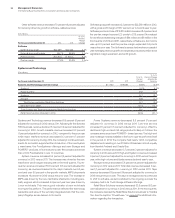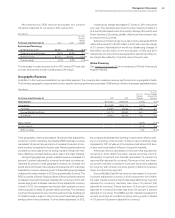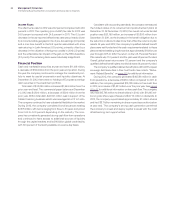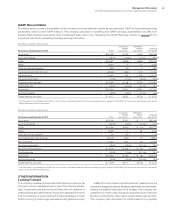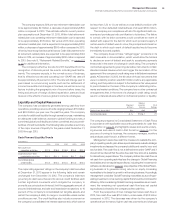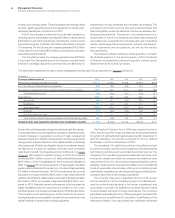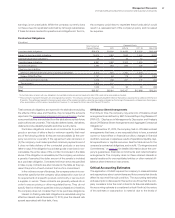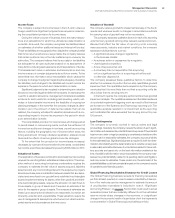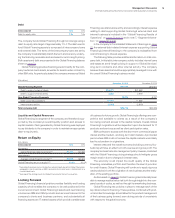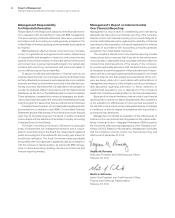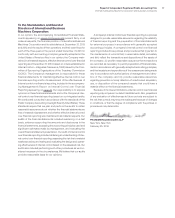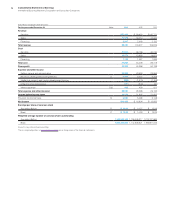IBM 2013 Annual Report Download - page 69
Download and view the complete annual report
Please find page 69 of the 2013 IBM annual report below. You can navigate through the pages in the report by either clicking on the pages listed below, or by using the keyword search tool below to find specific information within the annual report.
68 Management Discussion
International Business Machines Corporation and Subsidiary Companies
subjectivity and judgment involved, and (b) the impact within a rea-
sonable range of outcomes of the estimate and assumption is
material to the company’s financial condition. Senior management
has discussed the development, selection and disclosure of these
estimates with the Audit Committee of the company’s Board of Direc-
tors. The company’s significant accounting policies are described in
note A, “Significant Accounting Policies,” on pages 84 through 93.
A quantitative sensitivity analysis is provided where that informa-
tion is reasonably available, can be reliably estimated and provides
material information to investors. The amounts used to assess sen-
sitivity (e.g., 1 percent, 10 percent, etc.) are included to allow users
of the Annual Report to understand a general direction cause and
effect of changes in the estimates and do not represent manage-
ment’s predictions of variability. For all of these estimates, it should
be noted that future events rarely develop exactly as forecasted,
and estimates require regular review and adjustment.
Pension Assumptions
For the company’s defined benefit pension plans, the measurement
of the company’s benefit obligation to employees and net periodic
pension (income)/cost requires the use of certain assumptions,
including, among others, estimates of discount rates and expected
return on plan assets.
Changes in the discount rate assumptions will impact the (gain)/
loss amortization and interest cost components of the net periodic
pension (income)/cost calculation (see page 133 for information
regarding the discount rate assumptions) and the projected benefit
obligation (PBO). The company increased the discount rate assump-
tion for the IBM Personal Pension Plan (PPP), a U.S.-based defined
benefit plan, by 90 basis points to 4.50 percent on December 31,
2013. This change will decrease pre-tax cost and expense recog-
nized in 2014 by an estimated $264 million. If the discount rate
assumption for the PPP decreased by 90 basis points on December
31, 2013, pre-tax cost and expense recognized in 2014 would have
increased by an estimated $195 million. Changes in the discount rate
assumptions will impact the PBO which, in turn, may impact the
company’s funding decisions if the PBO exceeds plan assets. Each
25 basis point increase or decrease in the discount rate will cause a
corresponding decrease or increase, respectively, in the PPP’s PBO
of an estimated $1.3 billion based upon December 31, 2013 data.
The expected long-term return on plan assets assumption is
used in calculating the net periodic pension (income)/cost (see page
133 for information regarding the expected long-term return on plan
assets assumption). Expected returns on plan assets are calculated
based on the market-related value of plan assets, which recognizes
changes in the fair value of plan assets systematically over a five-
year period in the expected return on plan assets line in net periodic
pension (income)/cost. The differences between the actual return
on plan assets and the expected long-term return on plan assets
are recognized over five years in the expected return on plan assets
line in net periodic pension (income)/cost and also as a component
of actuarial gains/losses, which are recognized over the service lives
or life expectancy of the participants, depending on the plan, pro-
vided such amounts exceed thresholds which are based upon the
benefit obligation or the value of plan assets, as provided by
accounting standards.
To the extent the outlook for long-term returns changes such
that management changes its expected long-term return on plan
assets assumption, each 50 basis point increase or decrease in the
expected long-term return on PPP plan assets assumption will have
an estimated decrease or increase, respectively, of $256 million on
the following year’s pre-tax net periodic pension (income)/cost
(based upon the PPP’s plan assets at December 31, 2013 and
assuming no contributions are made in 2014).
The company may voluntarily make contributions or be required,
by law, to make contributions to its pension plans. Actual results that
differ from the estimates may result in more or less future company
funding into the pension plans than is planned by management.
Impacts of these types of changes on the company’s pension plans
in other countries worldwide will vary depending upon the status of
each respective plan.
Revenue Recognition
Application of the various accounting principles in GAAP related to
the measurement and recognition of revenue requires the company
to make judgments and estimates. Specifically, complex arrange-
ments with nonstandard terms and conditions may require significant
contract interpretation to determine the appropriate accounting,
including whether the deliverables specified in a multiple-element
arrangement should be treated as separate units of accounting.
Other significant judgments include determining whether IBM or
a reseller is acting as the principal in a transaction and whether
separate contracts are considered part of one arrangement.
Revenue recognition is also impacted by the company’s ability
to estimate sales incentives, expected returns and collectibility. The
company considers various factors, including a review of specific
transactions, the creditworthiness of the customers, historical expe-
rience and market and economic conditions when calculating these
provisions and allowances. Evaluations are conducted each quarter
to assess the adequacy of the estimates. If these estimates were
changed by 10 percent in 2013, net income would have been
impacted by $97 million (excluding Global Financing receivables
discussed on pages 73 and 74).
Costs to Complete Service Contracts
The company enters into numerous service contracts through its
Global Services business. During the contractual period, revenue,
cost and profits may be impacted by estimates of the ultimate profit-
ability of each contract, especially contracts for which the company
uses the percentage-of-completion (POC) method of accounting. If
at any time these estimates indicate the POC contract will be unprof-
itable, the entire estimated loss for the remainder of the contract is
recorded immediately in cost. The company performs ongoing profit-
ability analyses of its services contracts in order to determine whether
the latest estimates require updating. Key factors reviewed by the
company to estimate the future costs to complete each contract are
future labor costs, future product costs and expected productivity
efficiencies. Contract loss provisions recorded as a component of
other accrued expenses and liabilities were approximately $41 million
and $54 million at December 31, 2013 and 2012, respectively.


